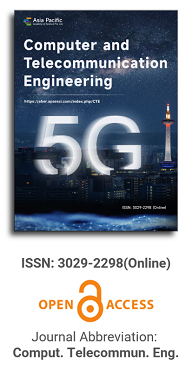
Adaptive beamforming approach for secure communication in 5G network
Vol 2, Issue 3, 2024
Download PDF
Abstract
The beamforming approach has been emerging as a very important concept for next generation networks. In addition to the improved channel capacity, spectral efficiency, energy efficiency, secrecy rate and secrecy outage probability, the upcoming fifth generation network mainly aims at enhancing the parameters of the channel for secure communication. In this paper, we have implied the allocation of resource blocks adaptively using HMM with a beamforming approach in an intruded network. A system model for secure communication in an intruded network has been discussed using a beamforming approach with the main motive being to provide a security scenario to the data which is transmitted over an unsecured channel in a network. In addition to this we have used the approach of HMM for allocating the resource blocks to the users which have been demanded and applied in order to avoid the intrusion and wastage of resource blocks.
Keywords
References
- Gupta A, Jha RK. A Survey of 5G Network: Architecture and Emerging Technologies. IEEE Access. 2015; 3: 1206-1232. doi: 10.1109/access.2015.2461602
- Han C, Harrold T, Armour S, et al. Green radio: radio techniques to enable energy-efficient wireless networks. IEEE Communications Magazine. 2011; 49(6): 46-54. doi: 10.1109/mcom.2011.5783984
- Asadi A, Wang Q, Mancuso V. A Survey on Device-to-Device Communication in Cellular Networks. IEEE Communications Surveys & Tutorials. 2014; 16(4): 1801-1819. doi: 10.1109/comst.2014.2319555
- Technical specification group radio access network; evolved universal terrestrial radio access. Available online: https://www.freecalypso.org/pub/GSM/3GPP/archive/36_series/36.300/36300-b70.pdf (accessed on 26 July 2024).
- Godara LC. Applications of antenna arrays to mobile communications. I. Performance improvement, feasibility, and system considerations. Proceedings of the IEEE. 1997; 85(7): 1031-1060. doi: 10.1109/5.611108
- Gandotra P, Kumar Jha R, Jain S. A survey on device-to-device (D2D) communication: Architecture and security issues. Journal of Network and Computer Applications. 2017; 78: 9-29. doi: 10.1016/j.jnca.2016.11.002
- Ma D, Tsudik G. Security and privacy in emerging wireless networks [Invited Paper]. IEEE Wireless Communications. 2010; 17(5): 12-21. doi: 10.1109/mwc.2010.5601953
- Claussen H, Ho LTW, Pivit F. Effects of joint macrocell and residential picocell deployment on the network energy efficiency. In: Proceedings of the 2008 IEEE 19th International Symposium on Personal, Indoor and Mobile Radio Communications. pp. 1-6.
- Derryberry RT, Gray SD, Ionescu DM, et al. Transmit diversity in 3G CDMA systems. IEEE Communications Magazine. 2002; 40(4): 68-75. doi: 10.1109/35.995853
- Wang CX, Haider F, Gao X, et al. Cellular architecture and key technologies for 5G wireless communication networks. IEEE Communications Magazine. 2014; 52(2): 122-130. doi: 10.1109/mcom.2014.6736752
- Nguyen VD, Duong TQ, Dobre OA, et al. Joint Information and Jamming Beamforming for Secrecy Rate Maximization in Cognitive Radio Networks. IEEE Transactions on Information Forensics and Security. 2016; 11(11): 2609-2623. doi: 10.1109/tifs.2016.2594131
- Chopra G, Kumar Jha R, Jain S. A survey on ultra-dense network and emerging technologies: Security challenges and possible solutions. Journal of Network and Computer Applications. 2017; 95: 54-78. doi: 10.1016/j.jnca.2017.07.007
- Alotaibi ER, Hamdi KA. Secrecy outage probability analysis for cooperative communication with relay selection under non-identical distribution. In: Proceedings of the 2016 IEEE Wireless Communications and Networking Conference.
- Zhang Y, Ko Y, Woods R, et al. Defining Spatial Secrecy Outage Probability for Exposure Region-Based Beamforming. IEEE Transactions on Wireless Communications. 2017; 16(2): 900-912. doi: 10.1109/twc.2016.2633351
- Yu B, Yang L, Ishii H. 3D beamforming for capacity improvement in macrocell-assisted small cell architecture. In: Proceedings of 2014 IEEE Global Communications Conference; 08–12 December 2014; Austin, TX, USA. 2014. pp. 4833-4838. doi: 10.1109/GLOCOM.2014.7037571
- Dugad R, Desai UB. A Tutorial on Hidden Markov Models. Available online: https://www.researchgate.net/publication/2348637_A_Tutorial_On_Hidden_Markov_Models (accessed on 18 March 2024).
Supporting Agencies
Copyright (c) 2024 Arunima Sharma
License URL: https://creativecommons.org/licenses/by/4.0/

Prof. Maode Ma
Qatar University, Qatar
The field of computer and telecommunications engineering is rapidly advancing, with the following being some of the latest developments.
more
We are pleased to congratulate the first anniversiry of the journal of Computer and Telecommunication Engineering (CTE).
more
Owing to the tireless dedication of the editor-in-chief, editorial board members, and the in-house editorial team, we are proud to announce the successful online launch of the first issue of Computer and Telecommunication Engineering.
Asia Pacific Academy of Science Pte. Ltd. (APACSCI) specializes in international journal publishing. APACSCI adopts the open access publishing model and provides an important communication bridge for academic groups whose interest fields include engineering, technology, medicine, computer, mathematics, agriculture and forestry, and environment.


.jpg)

.jpg)
